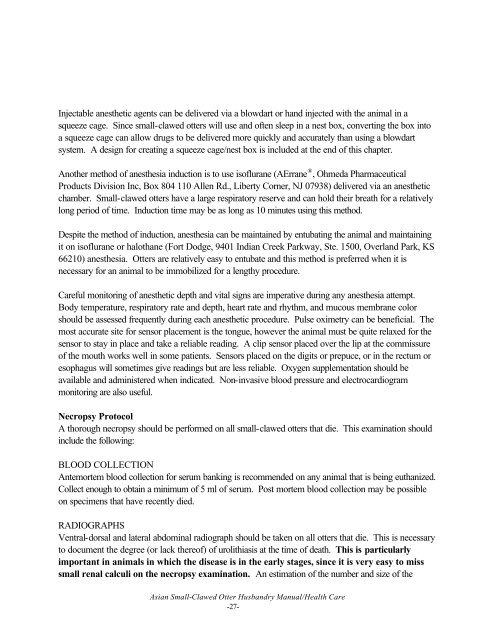Asian Small-Clawed Otter Husbandry Manual (1998)
Asian Small-Clawed Otter Husbandry Manual (1998)
Asian Small-Clawed Otter Husbandry Manual (1998)
Create successful ePaper yourself
Turn your PDF publications into a flip-book with our unique Google optimized e-Paper software.
Injectable anesthetic agents can be delivered via a blowdart or hand injected with the animal in asqueeze cage. Since small-clawed otters will use and often sleep in a nest box, converting the box intoa squeeze cage can allow drugs to be delivered more quickly and accurately than using a blowdartsystem. A design for creating a squeeze cage/nest box is included at the end of this chapter.Another method of anesthesia induction is to use isoflurane (AErrane ® , Ohmeda PharmaceuticalProducts Division Inc, Box 804 110 Allen Rd., Liberty Corner, NJ 07938) delivered via an anestheticchamber. <strong>Small</strong>-clawed otters have a large respiratory reserve and can hold their breath for a relativelylong period of time. Induction time may be as long as 10 minutes using this method.Despite the method of induction, anesthesia can be maintained by entubating the animal and maintainingit on isoflurane or halothane (Fort Dodge, 9401 Indian Creek Parkway, Ste. 1500, Overland Park, KS66210) anesthesia. <strong>Otter</strong>s are relatively easy to entubate and this method is preferred when it isnecessary for an animal to be immobilized for a lengthy procedure.Careful monitoring of anesthetic depth and vital signs are imperative during any anesthesia attempt.Body temperature, respiratory rate and depth, heart rate and rhythm, and mucous membrane colorshould be assessed frequently during each anesthetic procedure. Pulse oximetry can be beneficial. Themost accurate site for sensor placement is the tongue, however the animal must be quite relaxed for thesensor to stay in place and take a reliable reading. A clip sensor placed over the lip at the commissureof the mouth works well in some patients. Sensors placed on the digits or prepuce, or in the rectum oresophagus will sometimes give readings but are less reliable. Oxygen supplementation should beavailable and administered when indicated. Non-invasive blood pressure and electrocardiogrammonitoring are also useful.Necropsy ProtocolA thorough necropsy should be performed on all small-clawed otters that die. This examination shouldinclude the following:BLOOD COLLECTIONAntemortem blood collection for serum banking is recommended on any animal that is being euthanized.Collect enough to obtain a minimum of 5 ml of serum. Post mortem blood collection may be possibleon specimens that have recently died.RADIOGRAPHSVentral-dorsal and lateral abdominal radiograph should be taken on all otters that die. This is necessaryto document the degree (or lack thereof) of urolithiasis at the time of death. This is particularlyimportant in animals in which the disease is in the early stages, since it is very easy to misssmall renal calculi on the necropsy examination. An estimation of the number and size of the<strong>Asian</strong> <strong>Small</strong>-<strong>Clawed</strong> <strong>Otter</strong> <strong>Husbandry</strong> <strong>Manual</strong>/Health Care-27-
















